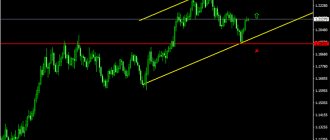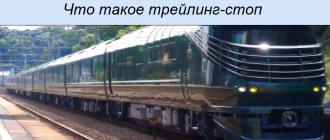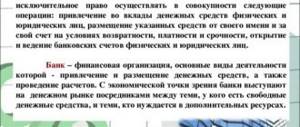Take profit is a trading tool aimed at fixing profits. It operates fully automatically and allows the trader to close the transaction in time when a specific price level is reached. Further in the article, how this tool works and how to use it.
Amega Bot is the latest tool for automated trading on the Binance exchange.
- Plus 20-30% to the deposit monthly in passive mode.
- Complete security of your funds, the bot cannot withdraw or transfer your money.
- Full transparency of all transactions and movement of funds.
You can find out the opinions of Amega Bot users in this Telegram channel.
My results can be viewed on this page.
To start working with the bot, click the button below.
Get Amega Bot
Stop loss and take profit - what is it in simple words
Take profit – a trade order to close a profitable transaction. Even the literal translation of the phrase means “to take profit.” The tool has won an audience due to the fact that it works automatically, i.e. the trader does not even need to be near the computer.
Both stop loss and take profit are position management tools. The difference between a set stop loss and take profit order is that the first one fixes losses, and the second one fixes profits. Stop loss and take profit are recommended to be used simultaneously.
Stop loss differs from take profit by the “trigger” price level. Being deferred orders, each of the instruments bides its time. And as soon as the price reaches a specific level, the deal is automatically closed.
Borrowing
In any living language that people use, you can find words that come from other languages and dialects. And this is an absolutely normal and natural process, although in every country there are radically minded citizens and politicians who believe that such borrowings violate the purity of their native language, are generally harmful and need to be replaced with domestic analogues. And, by the way, the French followed this path - they translate almost all new words.
The Russian language is no exception, and over the past twenty years, many words from English have appeared in it, to which people have become accustomed and actively use them. And one of these words is “profit”. So what is profit? Where did it come from and how is it used today? We'll figure this out.
Where to set take profit?
Take Profit is placed in a mirror manner relative to Stop Loss. When a purchase transaction is opened, the take profit must be set higher than the market entry point. When a sell deal is opened – below the entry point.
There are two methods of where and when to place a take profit order in trading:
- The first is at the moment when a deal is opened. This is the simplest and most effective method.
- The second is exposure during an open transaction. It happens that a trader did not have time to set take profit at the very beginning of the opening (for example, due to large price fluctuations or banal slowness).
Afterword
This is such a fun conversation we had today. By the way, at one time I also realized how important it is to speak foreign languages. And I started, of course, with English. By the way, if you are interested in useful literature for self-development, I have a good selection. Subscribe to my news and read!
PS And my advice to you: when you search on the Internet for everything related to the stock exchange, trading and investment, avoid links to “profit detector”! There was no such device and there is no such device, but catching the virus is as easy as shelling pears. This is what they often do: they disguise viral links with popular words and phrases from search queries.
Take profit examples
Let's say a player is going to take profit on a specific stock. To do this, he needs to specify a number of conditions in the terminal:
- type of stop order – TakeProfit (take profit);
- the validity period of the order is until cancellation;
- financial instrument – shares of a certain company;
- account – trader’s personal account;
- conditions for order activation – sale at a price level of 200 rubles;
- number of lots - 10.
So, the application has been completed. Now, when the quote reaches 200 rubles (according to the condition due to which the order is activated), the broker will begin calculating the cost of the order. Therefore, in addition to the data listed above, you must indicate:
- Allowable deviation from the highest cost. That is, a deviation from the maximum cost, upon overcoming which the application is also activated. Let's say the indentation is set to 8 rubles.
- Spread This is the difference between the activation price of the order and the price of the order that will be sent to the exchange. For example, it will be 5 rubles.
If the shares of the company from which the player purchased them continue to rise, the TP order will also begin to move after them. If the stock starts to fall, the take profit will remain in place.
Functions
The role of stop loss in limiting risk is clear - the order prevents the loss on the transaction from increasing. The function of take profit to reduce risk is not so obvious.
A well-known commandment of the market says: do not rush to leave a position, let the profits accumulate.
However, this thesis applies mainly to stocks and indices that are expected to exhibit continued long-term growth with moderate corrections.
It is assumed that the investor purchases an undervalued asset and waits for the price to rise. In this case, the expectation horizon is from 3-5 years, the time frame for entry is weeks/months.
Instruments on the crypto market are characterized by high volatility. Many coins are traded mainly in a range - between strong levels. The impulse is followed by a counter-impulse, which will take the profit back and easily knock out the trade with a stop (it’s good if it’s at breakeven).
The figure shows the pattern of a trade that would have been aborted due to a sharp lower test, although the intended target of a 50% retracement was subsequently achieved.
Bitcoin post-trend corrections have repeatedly reached 80+%. Therefore, when trading with crypto assets, take profit not only fixes profit, but also saves the trader from losing it, since it limits the risk of making an ineffective transaction.
How to install Take Profit
Setting take profit is possible both short and long. Setting take profit for beginners is actually not difficult. The main thing is to do it right.
On a short position
When a trader entered the market with a short position, his goal is to make a profit by reducing the price level. Accordingly, TakeProfit is set below the current price level. The level at which the order is placed must be calculated in advance.
On a long position
When a player enters the market with a long position, he aims to make a profit by buying cheaply and selling an asset expensively. Based on this, the take profit is set above the current price level. It is necessary to calculate the TakeProfit level in advance.
Summary
You know, dear friends, if I had come across this article at the very beginning of my investing career, I would have been able to avoid many mistakes. Today I tried to give you everything to make stock trading for beginners a profitable activity and not a waste of time, effort and money. Those of you who have been trading on the stock exchange for several days will be able to evaluate my opinion from the outside and, perhaps, diversify your arsenal of trading tools. Remember, success in the market depends only on you . It's up to you to decide what trading style to choose, when to enter the market, and when to close your positions. Based on your preferences, character and disposition, decide whether you need take profit or not.
For myself, I made a decision a long time ago. Since my trading, as a rule, is carried out in low- or medium-volatility times, I can easily close my orders manually. That's why I try to look for places where the market screams to me: “ THE REVERSE WILL HAPPEN SOON!” " This is where my profit taking point is.
Good luck with your trading, sober thoughts and huge profits. Write in the comments your opinions regarding whether a take profit order is needed or not, and do not forget to subscribe to blog updates. See you soon, friends!
If you find an error in the text, please select a piece of text and press Ctrl+Enter. Thanks for helping my blog get better!
How to calculate Take Profit?
First you need to find out what affects the change in the number of points between the cost of entry and the cost of an additional order. So this is:
- trading strategy chosen by the trader;
- set of tools;
- chart period;
- the amount of initial investment;
- position duration;
- psychology.
How take profit is calculated can be seen using a specific example:
- Let's say our capital is $3,000.
- Relatively speaking, the risk-to-reward ratio is one to two (1:2). By setting the risk value to 4%, we obtain the corresponding take profit level – 8% (multiplying 2 by 4).
- If we purchase one asset, the risk is $120 (4% of $3,000).
- You can diversify your risks and purchase two different assets for $1,500 each. And then the risk on one of the assets will be $60 (4% of $1,500).
Take profit strategy
There are several strategies to use TP effectively:
- Setting TP targets either based on support and resistance levels or based on risks that are set individually by the player. The best TP value directly depends on the level of risk set by the player. According to the standard, the risk-reward ratio is one to two or one to three.
- Partial fixation method. The bottom line is that you need to close each profitable position in parts once they reach the established price level.
- Application of an algorithm that will change the level of the initial TP trade order based on the current market situation. This is called a trailing stop. If the value of an asset systematically moves in the direction desired by the player, then the stop order is automatically pulled up along with it. The trader sets the distance to which he will approach independently (for example, 2%, 3%, etc.). And if the asset price turns around and moves in the opposite direction, the stop order will remain unchanged and continue to wait for the desired level.
Memes
With time and the widespread use of the Internet, it has developed its own subcultures, jargon and even legends. This process is natural and normal, since in any society or its virtual semblance people tend to unite into interest groups. The Internet also created, or, to be more precise, revived such a phenomenon as memes. A meme is a unit of digital or oral information that is characterized by a “viral” method of distribution. Simply put, it is a picture, phrase or something else that spreads among people almost independently of them. And relatively recently such a meme as profit became popular. It is almost always humorous in nature and is built on the following principle:
- to do something;
- do something else;
- …
- Profit!
Typically, this meme is used in a situation where you need to emphasize the absurdity, stupidity or humor of someone's strategy, activity or plan.
Maximum take profit size
Experienced traders advise limiting the take profit level. That is, as soon as it reaches its level, the trader stops trading for that day. It's all about emotions. Even professionals sometimes succumb to the will of feelings and cannot stop. If we present it in conditional percentage terms, then 2% is the maximum. Beginners should not take more than 1%.
Where to put Stop Loss?
Entry zones in the cryptocurrency market are general levels, round numbers, corrections of 50-60%. It’s more difficult with patterns - the patterns work on all crypto pairs, but only work on coins with the largest capitalization:
- Bitcoin and Cardano;
- Ethereum and Litecoin;
- Ripple, Tron and EOS;
- Bitcoin Cash.
Trading altcoins with low traded volume comes with a lot of market noise that disrupts classic patterns.
For any entry scheme, you need to determine the risk point - at which the forecast is refuted. Typically, such a point is a local extremum.
But when working with cryptocurrencies, you should understand that the capitalization of even coins from the TOP 10 relative to the fiat markets is small and allows large players to move prices and break stops in popular locations, since there are entire clusters of stop orders there.
To avoid frequent losses, there are two ways out:
Placement behind the obvious level with sufficient margin
The advantage is that the order will not be triggered very often.
The downside is that the potential risk will rarely be less than the target profit, which means the trading system is unstable.
Short stop after the first impulse towards the target
Plus - a good ratio of potential profit versus risk. The impulse is repeated a second or third time, often even more.
The downside is that you need to learn to recognize momentum and subsequent consolidation.
This scheme is obvious when it has already taken place. At the moment of formation, you have to focus only on the impulse + consolidation configuration.
Trigger for input after pulse:
- an impulse breakdown of a narrow, fairly long channel or continuation pattern has occurred;
- there is a stop-consolidation after the impulse;
- the appearance of shadows during the consolidation process as future stop loss points;
- before the next step the range of candles decreases.
Tapering of candles is a relative thing. Sometimes it is read visually as a literal decrease in range. Sometimes candles are simply internal, that is, they are hidden inside the range of the first and second candles of the stopping phase.
Additionally, you can connect an indicator and focus, for example, on divergence, aiming for a reversal impulse. Set the MA to 100 to understand the current priority trend. Or use other indicators.
Invisible stop - a special case
Invisible orders are used when working with Forex brokers. Both stop and invisible take profit are available in the MT4 library. The advisor sets orders that are not sent to the server, so the broker does not see them and cannot use manipulations against a specific trader.
Trading with a Forex broker is problematic due to wide spreads. But MT4 has a protective floating stop, a choice of margin leverage, hundreds of advisors and scripts. Some traders are accustomed to the functionality of MT4 and prefer to trade cryptocurrencies on Forex.
The list of Forex intermediaries with cryptocurrencies is located at ru.investing.com.
How to set Take Profit correctly?
To purchase
When buying securities or shares, the player wants its value to grow, because as a result he will make a profit. To buy shares at take profit and lock in profit, you need to set it at the top, above the cost of opening the position. Then SL should be below the opening cost to limit possible losses.
For sale
When selling, the player is determined to see the price fall, i.e., the chart will move down. Accordingly, it is necessary to record income and enter TP at the bottom - below the opening cost level. SL in such a situation is placed at the top, since a loss will be possible due to a rise in price.
When working on the currency exchange, a Forex player's profit is often reduced due to various commissions.
[edit] Links
- Profit is such a profit
- "Eurostandard Profit M"
| [ + ] 1) PROFIT 2) ??????? 3) PROFIT! | |||||||||||||||||||||||||||
| |||||||||||||||||||||||||||
When does Take Profit not work?
In gaps
Gaps are gaps between the opening and closing prices of the next trading session. Most often, gaps occur in commodity markets because they do not operate around the clock. And while they are inactive, the price continues to change. This is the reason for the significant difference in price levels. In the Forex market, gaps are rare, since the currency exchange operates continuously.
High volatility
It happens that TP does not work due to high volatility. If we explain it using a very conventional example, the situation looks like this: the trader has set TP at a specific price level of the currency - 50. And the current market value of this currency is 46. And suddenly a shaking and shocking event occurs, because of which the market value of the currency quickly jumps to 55.
The point is that the 50 mark never happened. Therefore, the deal cannot be closed at this level. The broker will close the deal at 55, which is much more profitable for the player.
Large position volume
Market trading using large amounts can lead to the fact that the broker simply will not have time to sell the trader’s instruments at the required price. Inevitably, one part of the assets will be sold at one price, and the second at another.
This situation rarely arises because we are talking about really huge amounts.
What problems can profit limits help solve?
Limit is the cure for greed
On average, for a trader, greed goes away after 3-4 years, each in his own way. A person is basically greedy, you just have to accept it as a given. Sooner or later you will encounter, or have already encountered, a situation as demonstrated in this diagram:
Market situation of non-compliance with profit limits
Here you correctly calculated the direction of the tool, and even went well. As a result, most of the movement was given to the market. That is, the deal was closed with a slight gain or breakeven. It also happens that already in your first trade of the day, with good movement, you can reach the daily profit limit. Then, if you use it, it will not allow you to sit out!
Profit limit is a panacea for anxiety
When you are in the market, regardless of your professionalism, you experience emotions. The more practice, the less emotions, but they are still there. It is difficult for the brain to explain that the numbers on the screen are just numbers.
However, such numbers are associated with money, and money is a matter of survival!
The longer you stay in a position, the more stress accumulates. And the accumulated stress needs to be thrown out somewhere. You can take advice from the movie The Wolf of Wall Street . Maybe this will help. I prefer to cover myself in parts. Thus, shorten your stay in the market.
Video lessons by Artyom Zvezdin
VSA analysis must be studied consistently, otherwise there will be no point.
I suggest you plunge headlong into awesome video lessons from the pros. Find out everything about VSA and get tips and secrets
If you feel that stress is growing and growing, then it is very easy to get into a “logical loop” . Where you will begin to enter and exit positions, average or pyramid with the trend. In the end, you will be right in your analysis, and even take the right direction. And you will come out with a minus or at breakeven.
As a psychologist, setting a profit limit is understandable to me. It creates some kind of framework, along with risk for the day. In which the trader somehow works and exists. The profit limit acts as a kind of bar that the trader is guided by. Thus, it protects emotions from anxiety.
Reached the limit - closed the day. If you haven’t reached it, sit and wait!
Advantages and disadvantages of TakeProfit
According to traders, the advantages of TakeProfit are:
- Closing a deal manually is difficult and sometimes impossible. After the price reaches a high or low level, it immediately rebounds if it is in a narrow channel. And take profit allows you to fix the best profit indicator in advance.
- "Taming" greed. This is true for both beginners and experienced players. An obsession with constantly increasing income will lead to the fact that at one point the price will sharply turn in the opposite direction and the trader’s profit will become zero.
But part of the trading community is neutral or negative towards this instrument. And there are two reasons for this:
- No 100% guarantee. TakeProfit does not guarantee that the price level will change exactly where you set it. In fact, no analytical tool can accurately predict price behavior. Its volatility depends on a huge number of factors, including even news reports or fake news.
- Often, with proper market analysis, it is easy to independently understand when to enter and when to exit.
Profit factor and other definitions appearing on exchanges
Profit-factor is a numerical value characterizing trading efficiency. It is calculated as the amount of transactions completed with a profit, divided by the amount of transactions completed with losses.
If the profit factor value is greater than one, the trade is successful, and if it is less, the trade is unprofitable.
In practice, it is believed that the optimal values of this value are above 1.6. The higher the profit factor, the more successful the trade.
In the exchange environment and on Forex trading platforms, other definitions related to profit are used :
- profitable transaction - one that brought profit to the trading participant;
- profit indicator – the indicator that will give the correct signal to open a successful transaction;
- A profitable strategy is one that brings regular profits.
Summarizing
A large number of tools and mechanisms have been developed for trading on the stock exchange, which are designed to reduce the player’s losses to a minimum. And take profit is one of the trading tools. When opening a position on the stock exchange, investors always want to remain in the black. By fixing a specific level of profit, the player protects himself not only from potential losses, but also from excitement. So, the main points discussed in the article are:
- On the chart, take profit looks like a straight broken line, located either at the top or bottom (depending on the player’s strategy). Most often it is green.
- The principle of operation of the instrument is extremely simple: the player, being long, wants to fix his profit. To do this, he sets up the TP so that when the price reaches the level set by the trader, the order is activated. If the player shorts, take profit is set to buy.
Useful materials on the topic
Subscribe to my newsletter. Many more articles will be published soon on trading terms, trading strategies, general concepts of financial literacy, and investments. Subscribing will allow me to send you links to new publications directly to your email.
Check out my selection of trading courses. I start it with free materials that I have personally studied. They are all very in-depth, high-quality, systematic. When you have studied everything free, you can move on to paid courses. Although, I do not advise you to do this, everything good is on the Internet in the public domain.
If you are too lazy to watch the courses, you can watch this video right now. This is the first lesson of the basic course on trading in the foreign exchange market. It was held offline and broadcast on the Internet. The same ordinary people like you were sitting in the hall, so everything was explained in understandable and accessible language.
Today I don’t think it’s actually possible to make money from trading. If this were real, the richest people would be traders, not Musk, Bezos, Gates, Buffett and others. And the stock exchange would not have existed a long time ago - someone alone would have pumped all the money out of it.
I believe a better use of your money and time is to learn passive investing. And investments in general. If you agree with me, I can recommend you the course “Personal Finance and Investments,” which I studied personally. On it, professional investor Sergey Spirin explains the basics of profitable investment of money, introduces listeners to the main types of investment instruments, and provides excellent literature for further development.
The course is paid, currently costs 7,210 rubles. The course materials will remain with you forever, and you can return to them and review them at any time.
In addition to the course, pay attention to materials from the City of Investors. This is an educational resource on investments, both I and Vasily Blinov, who created this site, study it. Here, for example, three books, they are small, are quite suitable for a first acquaintance with investing. Books are free, download and read.
- How to become financially independent in 1 year.
- 5 ways to effectively invest 1000+ rubles.
- 6 steps to financial security.










